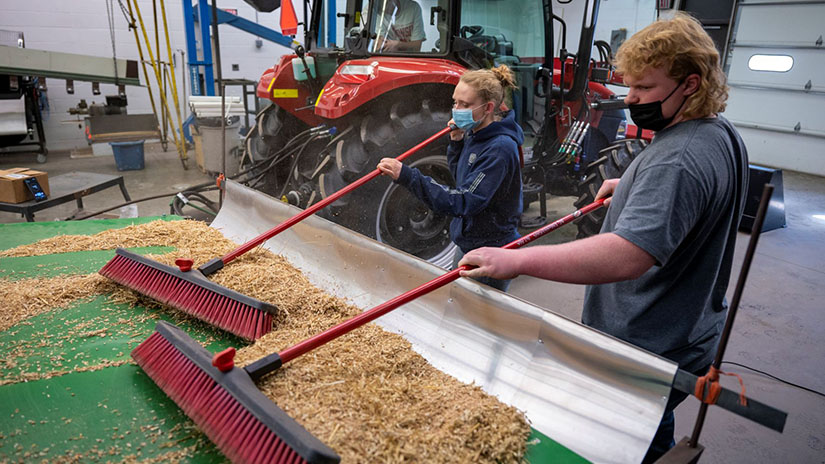
Students Rames Frisch, in tractor, Alex Pierson and Kyle Leis conduct research to determine how to improve a 1960s combine’s performance.
University of Wisconsin-River Falls agricultural engineering and agricultural engineering technology students are researching ways to make older combines more efficient and improve profitability for smaller farmers.
The research is part of a $150,000 United States Department of Agriculture grant led by Sierra Howry, associate professor of agricultural economics, and Matt Digman, former assistant professor of agricultural engineering.
Using a 1960s Oliver combine, agricultural engineering senior Alex Pierson, of Mayer, Minn., along with junior Kyle Leis, of Wilton, and Rames Frisch, a first-year student of Wausau, both agricultural engineering technology majors, developed two methods to potentially make the combine more efficient in harvesting with a new header configuration.
One method used a series of small brushes bolted to the head auger to help push the wheat grains toward the middle of the auger and hence being better transported to the feeder house. The other used a 5/16th piece of plastic sheeting to help fill the space underneath the auger and prevent loss of grains.
The students worked with Bob Zeng, assistant professor of agricultural engineering, and Youngmi Kim, associate professor in agricultural engineering.
“The students are redesigning old equipment to improve the productivity, efficiency, profitability and sustainability of small farms in support of local farming movement toward low carbon footprint circular food production systems,” Zeng said.
Smaller farmers – those with five to 50 acres– may not be able to afford new combines and could potentially increase productivity with a low-cost redesign.
“It is more affordable for small-scale farmers to be more efficient rather than buying new equipment,” Pierson said.
Initial data suggests the shim created high 90% efficiency and the brushes in the upper 80% efficiency, compared to 80% efficiency with no modifications. However, the students will analyze the data further. They will eventually share their findings with stakeholders including local farmers.
Being a part of the research as a first-year student created a hands-on learning environment, Frisch said.
“It definitely teaches you a lot just coming into a project,” he noted.
Leis agreed. “I like to work with my hands slinging wrenches,” he said, noting an important part of the project to him was making sure farmers would have the skillset to redesign their equipment cost-effectively.
Kim noted the project allows students from different majors to work collaboratively.
“It is beneficial in the real world,” Kim said. “They are getting the experience of working as a team. It challenges students. Students must understand the problems. They must think of alternative solutions, compare them and choose the best one to solve the problems. They gain project management skills. They will present their work to the Industry Advisory Board members in May.”
Pierson, who graduates in May, said being part of a design and research project is a tremendous addition to her resume.
To learn more about the program, email Zeng at zhiwei.zeng@uwrf.edu.
UWRF’s agricultural engineering degree offers three focus options including machinery systems; food and process systems; and natural resources and environmental systems.
The agricultural engineering technology degree focuses on applied science and engineering and using existing technology to solve real-world problems in the food, fuel and fiber industry. The university also offers a minor in agricultural engineering technology.
By University Communications and Marketing, UW-River Falls
Link to original story: https://www.uwrf.edu/News/Studentslearnteamworkresearchskillstomakeoldercombinesmoreefficientandprofitableforsmallfarms.cfm
